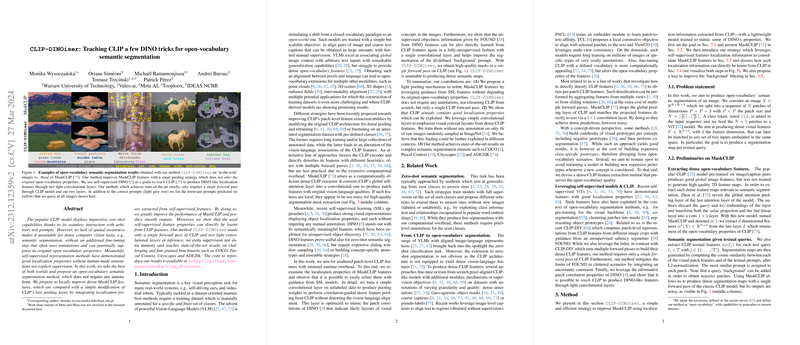Semantic Segmentation Enhancements through Self-supervised Learning and CLIP Integration
In the field of computer vision, open-vocabulary semantic segmentation has remained a challenging task, primarily due to the limitations of existing models in adapting to spatial awareness without annotated datasets. The research paper titled "Teaching CLIP a few DINO tricks for open-vocabulary semantic segmentation" addresses these challenges by leveraging the strengths of both Contrastive Language–Image Pre-training (CLIP) and self-supervised Vision Transformers (ViT), particularly DINO, to enhance semantic segmentation without the need for pixel-wise annotations.
Core Contributions and Methodology
At its core, the paper introduces a novel approach that combines the zero-shot capabilities of CLIP with the spatial awareness of DINO, a self-supervised learning method. The primary contribution is a technique to locally refine dense MaskCLIP features, allowing the CLIP model to produce more accurate semantic segmentation outputs. This is achieved by integrating localization priors extracted from DINO’s self-supervised features, thus smoothing the segmentation outputs and improving their accuracy.
The method comprises:
- Dense Feature Extraction: By converting CLIP's global self-attention to a convolutional mechanism, the paper enhances patch-level feature extraction without losing open-vocabulary properties.
- Guided Feature Pooling Using DINO: DINO’s patch correlations, known for capturing semantic similarities, are employed to refine CLIP's feature maps, reducing noise and improving spatial segmentation.
- Learning Localization Directly from CLIP: The authors demonstrate that CLIP’s features can be trained to exhibit DINO-like localization properties through lightweight convolutional layers.
- Background Detection: The paper employs FOUND, a foreground-background segmentation method, to detect and refine background identification, addressing the challenge of hallucinated segmentations in fuzzy areas, effectively reducing false positives.
Results and Implications
The method is evaluated across multiple complex datasets, such as COCO, Pascal Context, and ADE20K, achieving state-of-the-art performance despite its simplicity — requiring only a single forward pass through the CLIP model with two additional convolutional layers. Notably, the results showcase improvements over traditional MaskCLIP, especially in handling intricate and cluttered scenes, by harnessing SSL's localization capabilities.
The implications of these findings are manifold, suggesting that spatial refinement of existing models using self-supervised signals can significantly advance open-vocabulary segmentation tasks without incurring the high annotation costs typical of dense prediction tasks. This approach also paves the way for future work in exploiting self-supervised models for enhancing model interpretability and spatial reasoning in AI systems.
Conclusion and Future Directions
This work on integrating CLIP's open-vocabulary strengths with DINO's self-supervised localization introduces a practical yet impactful method for advancing semantic segmentation. Future research could explore more sophisticated convolutional architectures to further enhance feature localization, as well as extend this framework to other modalities requiring spatially detailed understanding, such as 3D vision and point cloud segmentation. There is also potential to expand this method's adaptability to novel datasets and unseen classes, enhancing generalization and application scope in real-world scenarios.
